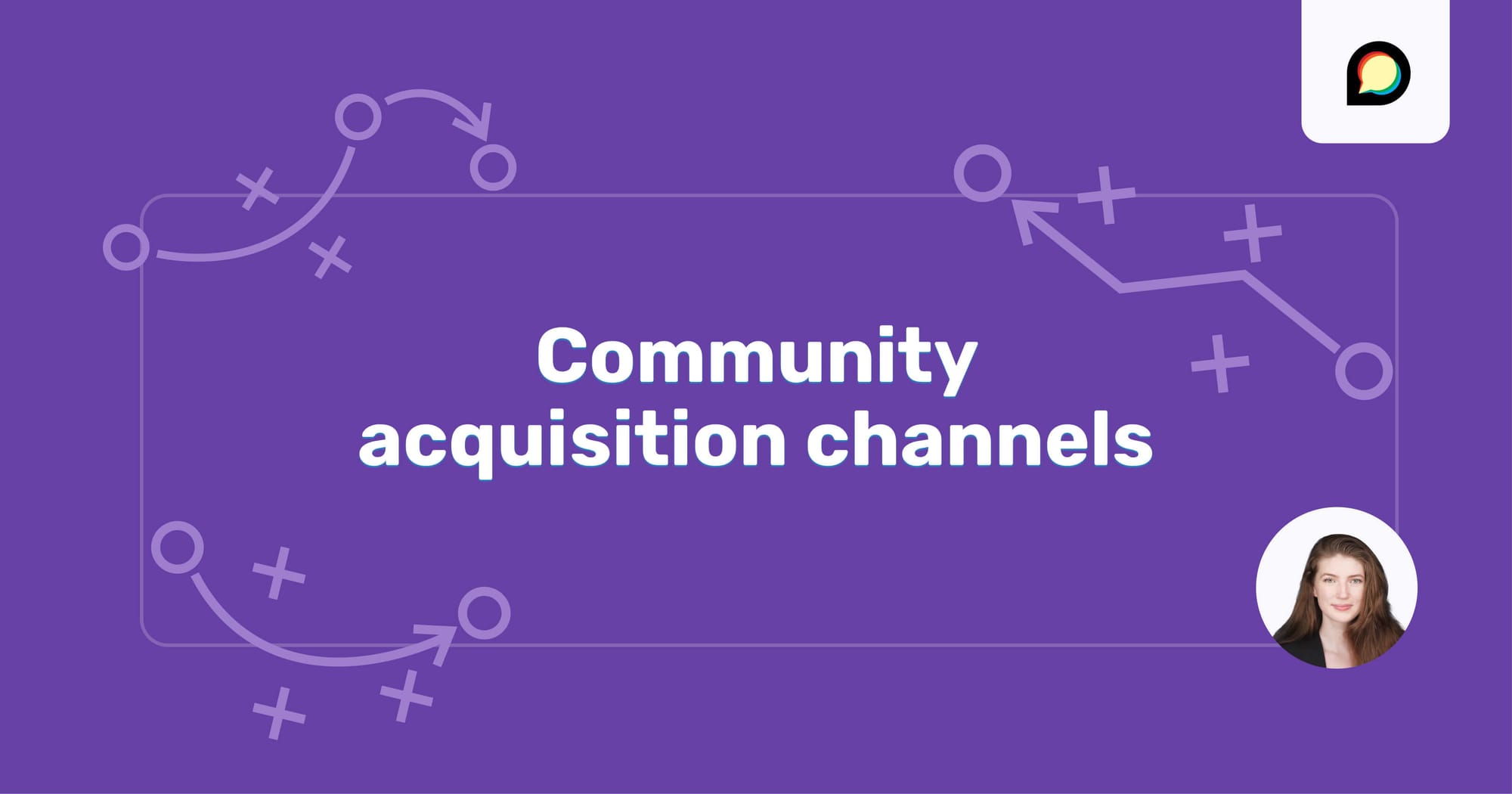Community Acquisition Channels: Beyond "Build It and They Will Come"

Too many communities are launched with the “if you build it, they will come” mindset, only to find empty discussion boards and disengaged members. Successful community growth doesn’t happen by accident. You need a deliberate acquisition strategy that goes beyond vanity numbers and focuses on attracting the right people.
The Field of Dreams Fallacy
The biggest myth in community building is the idea that if you simply build a space, people will naturally show up and engage. In reality, communities face a tough cold start problem; reaching those first 100 active members takes more effort than scaling from 1,000 to 10,000.
Unlike product acquisition, where you can rely on ads, funnels, or incentives, community acquisition follows a different set of rules, built on trust, alignment, and shared purpose. The acquisition choices you make in those early days are critical — they compound over time, shaping the culture, growth trajectory, and overall health of your community.
The Community Acquisition Framework
A strong acquisition strategy starts with knowing exactly who you want to attract, not just by age or job title, but by motivations, values, and what they hope to gain from joining. Call it an ideal member profile, and you can use it to map their journey from discovering your community to becoming an active, contributing participant.
Separate acquisition (getting someone in the door) from activation (getting them to engage) and retention (keeping them coming back). Each of these comes down to different tactics and metrics. Your growth playbook has to align with the type of community you’re building and the outcomes you want it to drive.
Content Marketing That Actually Builds Communities
Most content strategies are designed to attract readers. A community-first content strategy needs to attract participants. The goal isn’t just driving pageviews; it’s creating curiosity, encouraging conversation, and planting the desire to belong.
By consistently publishing content that demonstrates thought leadership in your niche, you signal authority and credibility. People naturally gravitate toward communities led by experts, especially when they see genuine insights and practical value they can’t get elsewhere, but you have to show that expertise to the outside world. If you want your community’s knowledge to drive community membership, it can’t just be gated away
The good news is that in this new era of AI SEO, community content is very powerful. Online communities are your unfair advantage in the AI search era.
Remember: the goal isn’t just to rank, it’s to convert search traffic into members. High-ranking evergreen posts, Q&A-style articles, or resources that solve real problems can serve as powerful entry points. When optimized for both visibility and conversion, these assets bring in the right people who are likely to stay.
The distribution of your content is just as important as the content itself. Instead of spreading thin across every channel, reverse engineer your distribution on the platforms where your ideal members already spend their time. LinkedIn, Reddit, niche newsletters, podcasts, or even guest posts in adjacent communities can become high-leverage channels. The key is connecting your content back to your community space. A blog reader who finds value in your content should always see a clear path to becoming a community contributor, whether it’s through a call-to-action, a discussion thread they need to contribute to, or a direct invitation.
Strategic Partnership Channels
Partnerships can be one of the fastest ways to grow a community if you choose the right partners. The idea is simple: find complementary communities and organizations that share your audience (but aren’t direct competitors) and create cross-promotion opportunities that benefit both sides, from newsletter swaps to joint content campaigns. For communities serving professionals, integration partnerships with tools your target members already use - like Obsidian, Notion, or project management software - can create seamless entry points.
Referral Programs That Work
Referrals are a powerful growth lever for communities, but they fail when you treat them like traditional product referral programs. Offering gift cards or cash payouts feels transactional and will only attract the wrong type of members. The best community referral systems are designed to be natural and organic, tapping into the pride members already feel in belonging. Think about what you can do to encourage introductions between professional connections. Create lightweight shareable invites that make it easy for members to bring in peers.
Gamification is still powerful. Recognition-based approaches like spotlighting top referrers, granting special status, or unlocking exclusive access often work better than purely financial rewards. And not all recognition needs to be public; at Discourse, we’ve found even a personal one-to-one thank-you from a community builder to a contributor can go a long way. As with everything — keep it aligned with the culture of the community.
Where it’s possible (without being invasive), tracking referrals can help you learn what's working and what's not. If you can, and if your community approves, measure both referral volume, and the quality and retention of referred members, so you can refine and lock-in on the strategies driving growth.
Direct Outreach and Personal Recruitment
In the early stages of a community, nothing beats a personal invitation. Reaching out directly to potential members signals that they’re valued, and it sets the tone for a high-quality, engaged group.
For cold outreach, lean on authenticity over volume. Personalized messages that highlight why someone’s perspective or expertise would add value are far more effective than mass emails.
Existing professional networks can be a goldmine. Colleagues, clients, and industry peers are often open to joining if they understand (and if you can articulate) the community’s purpose. You could also take an “influencer” approach, recruiting catalysts and connectors who will naturally bring others with them.
But don’t make the mistake of building entirely on someone else’s personality or audience. If your whole community is balanced on a handful of power influencers, it’s a precarious way to exist.
Platform-Specific Acquisition Strategies
The acquisition strategy that works across every platform is simple:
- Be a leader, and people will want you to lead.
- Care about the community, and people will want to join yours.
- Sharing your expertise, being generous with your knowledge and asking how can I help are stronger than any growth hack.
LinkedIn: professional community building and thought leadership
For professional or B2B-focused communities, LinkedIn is still the highest-leverage channel. Instead of posting generic promos, use your personal profile to demonstrate expertise and extend community invitations. The best LinkedIn growth comes from comments and DMs, not just posts.
Twitter/X: engaging in relevant conversations and building authority
Twitter/X is still the internet’s default tool for text-based conversation and network-building. Rather than blasting announcements, engage directly (and personally) in discussions, amplify member insights, and share high-value takes. Over time, this positions you as an authority in your space, making community invitations a natural extension of your online presence. Note: thoughtful replies outperform original tweets when it comes to sparking genuine interest. Just don’t make the mistake of trying to automate your engagement…
Reddit: authentic participation in existing communities
Reddit can be a goldmine for discovery, but it punishes anything that smells like self-promotion. Participate in existing subreddits, answer questions, offer resources, and become a trusted contributor before ever mentioning your own community. Once credibility is established, a carefully placed invitation to “continue the discussion” in your space can generate high-quality new members who are already invested in the topic.
Industry forums: becoming a valuable contributor before promoting your own community.
Legacy forums and niche digital communities may not have the hype of newer platforms, but they often hold concentrated groups of the exact people you want to reach. Just like Reddit, the rule here is value first, promotion later. By consistently contributing insights, guides, or thoughtful responses, you position yourself as a peer worth following. Only after you’ve built that trust does it make sense to introduce your own community as a natural next step.
Event networks: conferences, meetups, and professional gatherings
In-person and virtual events remain underrated acquisition channels. Conferences, meetups, and industry gatherings are moments when people are actively looking for connection and belonging. Hosting side events, exchanging speaker opportunities, or simply inviting new contacts to join post-event discussions can work.
Measuring Acquisition Success
Not all growth is good growth. The measure of acquisition success isn’t just how many people join, but whether they’re the right people who stay active and contribute. Quality should always outweigh raw quantity.
Do LinkedIn referrals engage more deeply than event sign-ups? Does SEO bring in lurkers or contributors? By tracking the full member lifecycle from the first click to active participation, you can see which channels truly drive value. A cohort analysis based on acquisition channel sources can help you separate growth signals from noise.
Common Acquisition Mistakes
Even experienced community builders fall into traps that undermine long-term growth. The most common mistake is chasing vanity metrics and celebrating new sign-ups while ignoring whether those members ever engage or forgetting the members who have been with you since day one..Bringing in members who don’t align with the community’s culture or goal dilutes the experience for everyone else..
Remember: aggressive or inappropriate outreach won’t do you any favors. Burning bridges in the name of short-term growth can permanently damage your reputation and make future acquisitions harder.
Scaling Acquisition Systems
At some point, every community builder asks the same question: should we pay to accelerate growth? The answer isn’t “never,” but it’s definitely “not until you know who belongs.” If you can’t describe your ideal member and predict what they’ll do after joining, paid acquisition is just expensive noise.
When you do scale, treat it as a team sport. Community managers can nurture engagement, but acquisition is bigger than one role. Marketing, partnerships, even product all shape how people find and experience your space. The strongest communities don’t silo growth; they weave it into the fabric of the whole organization.
Tools matter too. A thoughtful stack of referral loops, CRM integrations, and automation that saves hours instead of creating busywork turns scaling from a slog into a system.
But you need a line in the sand: culture comes first. Growth that erodes trust, belonging, or shared purpose is a false victory — building numbers without the trust and participation that make a community thrive.
Long-Term Acquisition Strategy
Community growth is less like building a funnel and more like tending a fire. You don’t “launch” acquisition; you keep feeding it with the right kind of fuel at the right stage. The sparks that bring in your first 50 members won’t keep a community of 5,000 alive.
In the early days, you win by handshakes, personal invites, one-to-one conversations, and founders pulling people in themselves. At scale, you need systems: repeatable loops, integrations with where your people already spend time, and rituals that make members invite others without thinking twice.
The mistake communities make is treating growth as a bolt-on project. But acquisition and culture are inseparable. Every new person changes the texture of the room. If you don’t evolve how you attract them, you end up mismatched — either stuck small or growing into something brittle.
Lasting communities compound because they treat acquisition as a craft: always tuned, always aligned with purpose, always feeding back into the culture that made the community worth joining in the first place.
Ready to attract the right members to your community? We’ve created an Ideal Member Profile sheet to help you move beyond vague demographics to understand who you’re really building for: their challenges, motivations, and what makes them stick around. When you’re crystal clear on your ideal member, every decision from platform features to content strategy becomes easier.
